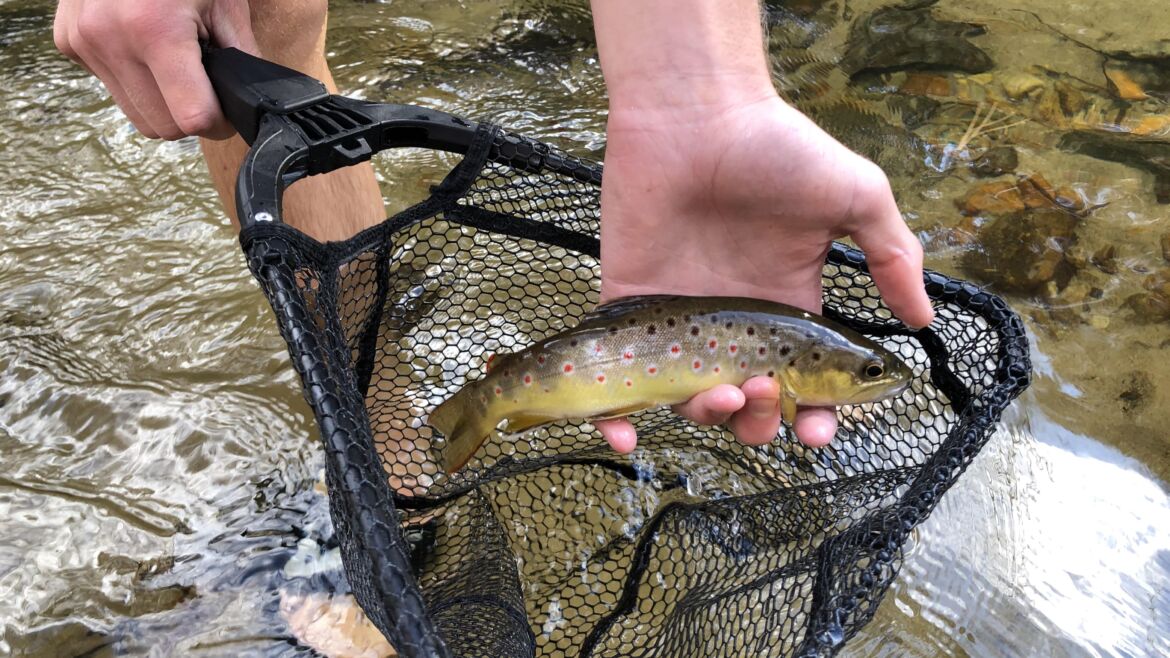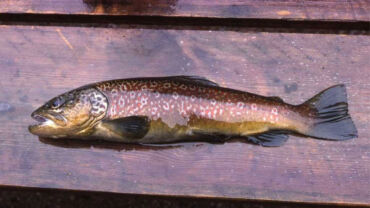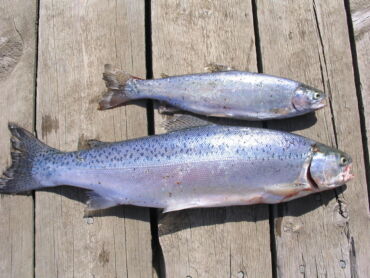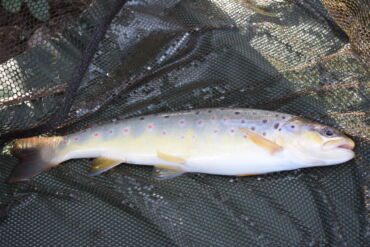River trout fishing is on the rise in popularity across the United States. As someone who has recently gotten far more into trout fishing in rivers in the past couple of years, I find this to be such a fun article to write.
For the most part, due to regulations and precedent, most trout fishing in rivers is done by using fly fishing gear, although people occasionally use spinning gear. Due to this reason, I’m going to be specifically talking about fly fishing for the entirety of this article.
Fishing rivers are very unique compared to most other kinds of fishing. For example, most bass anglers have only fished stagnant bodies of water like lakes and ponds. Still, other types of anglers, like saltwater fishermen, usually fish in vast, slow-moving bodies of water like the ocean. Rivers are different because they present a whole new environment and set of challenges to the angler. You have various obstacles like trees and rocks in addition to differing currents and eddies.
Fish also hide in completely different areas than other bodies of water, making it a whole new game of how you have to find the fish. To make this arena of fishing even more challenging, add in trout, a species notorious for being picky and very on and off when it comes to the bite. Rivers themselves make trout fishing a challenge, but the trout also make it harder, given that their bite pattern and preferred prey can change on any given day.
To help you guys better understand the fishery where you are fishing, I would recommend downloading the Fishbox App. The app analyzes different metrics based on the location you are fishing to give you the best picture of what you can expect the bite to look like. So don’t wait; download the Fish Finder App today.
Get your personalized fishing map
Answer a quick quiz and get your own personalized fishing map
Understand Trout River Behavior
Before we get into the actual catching of trout, we need to discuss the behavior of the trout and where they like to hide in the rivers. First, we’ll start with where trout tend to hide in rivers. Trout tend to stay near the bottom, often in deeper pockets and eddies where the current goes from fast to slow—so they can grab prey when it comes by. Trout also tries to hide behind natural obstructions like rocks, ledges, and trees where the current slows down a bit.
Next, let’s discuss the general behavior of trout. Trout are very temperature and environment-based feeders. When the trout are in the right state, they can feed super aggressively, but at other times, they can be super slow and sluggish, such as when the water is too cold or too warm. You’ve probably seen videos of trout airing out on bugs, and this just shows how aggressive they can get.

In the same line of thinking, I want to discuss a bit about how the trout bite changes around the year due to season, weather, and water conditions. First, the seasons you will be most productive in should be Spring and Fall. Keep in mind this is not for every river ever, but for the vast majority, this holds. Spring and fall are the Goldilocks zone, where the temperature is not too hot or cold.
Additionally, that brings me to my next point—weather. If you want a temperature between the high 30s and mid-60s, this should yield the most optimal results. Cloud cover also tends to produce better results than direct, clear sunlight.
The last thing I want to mention is the water condition. Again, you want that Goldilocks spot. It is not too murky or blown out but also not stagnant and crystal-clear cause the trout will be able to see you.
Read also: Maximize Your Catch: Guide to the Best Freshwater Fishing Baits
One more thing I want to mention briefly in this section is feeding patterns. I’m sure you’ve heard the phrase “match the hatch” so this should make sense. There are tons and tons of different bugs, larvae, and flies that trout feed on throughout the year in rivers. In fact, the bite pattern is always almost changing. As a result, your best bet is to hit up your local fly shop and ask them what trout have been biting lately. They should be more than happy to help, especially if you support their business.
Essential Gear for Trout Fishing
Much like any other type of fishing, river fly fishing for trout requires specific gear, but it always ends up being a personal preference at the end of the day. Additionally, because rivers vary in size so much, as do the trout in them, there’s not much help I can really give when talking about gear. However, I can tell you about the gear that I generally use. I fish medium to small rivers and streams with a 9-foot, 5-weight fly rod. I use a floating line with a tapered leader, which is then connected to a 5x or 6x tippet. Keep in mind that the trout I normally target are pretty small; we’re talking 2 pounds or less 99% of the time.
Since fly fishing is legal in almost every river system in America, when I talk about baits—or more specifically, flies—that is what I’m going to be referring to. Spin fishing can be an extremely effective tactic; you just have to ensure it is legal in the river you are fishing. If you can spin fish, I would recommend using a smaller rooster tail.
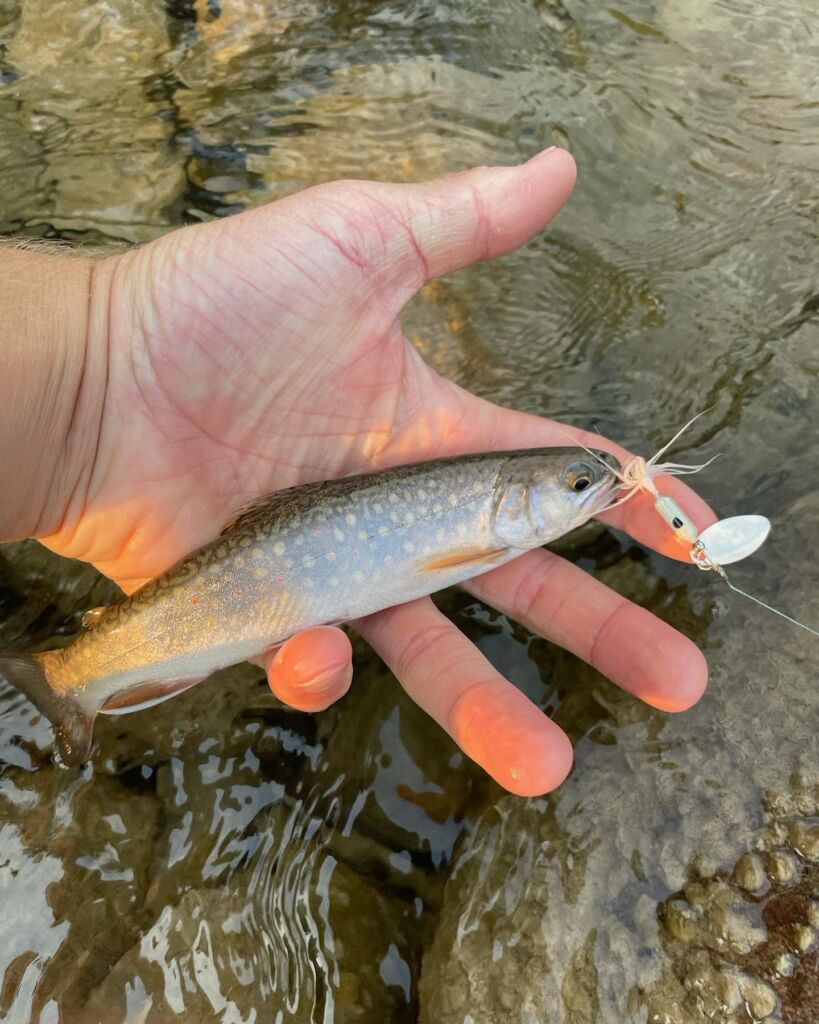
Again, since rivers are so different everywhere in this country, it really doesn’t help that I give you some flies to use because I could be telling you about a fly that worked in one place and not in another. This being said, go ask local shops what’s biting, and they’ll show you the flies and lures you need to use to have the best chance of catching trout.
Lastly, the only other gear we need to discuss is waders, booties, nets, etc. You will want a net because you rarely land a trout if not. Additionally, if you are fishing in cooler or cold water, you will want waders and/or booties in order to stay warm. This is most, if not all, of the essential gear for trout fishing rivers.
Top Techniques for Catching Trout in Rivers
In this section, I’m going to briefly go over some techniques on how you can be more successful in catching trout in rivers near you.
- Drift fishing: Although I have never tried this form of fly fishing, I know a bunch of people who have. Drift fishing is just like any other kind of fly fishing except for the fact that you are floating down the river, which gives you more access to hard-to-reach spots. The only downside is that it’s hard to stay in one place because you are, in fact, drifting.
- Fly fishing: This is pretty much the overall topic of this entire article, but fly fishing is almost always going to be your best bet if you want to yank some trout out of a river.
- Spin fishing: This can be a deadly form of river trout fishing if it is legal. Run a rooster tail across areas where the river goes from fast to slow for your best chance of getting a bite. Another advantage of spin fishing is that people are generally more accurate with a spinning rod than a fly rod, so you can make more precise casts a bit easier.
- Nymphing: This is one of my favorite ways to target trout. It involves using an indicator, sort of like a bobber, with a little nymph under it to find some of the deeper-dwelling trout. It is so satisfying to watch that little indicator go under and make the hook sets even sweeter when you finally make that connection. The best way to nymph is to cast your fly into a section of a fast river that goes into a slower area like an eddy or deep pool.
Best Locations and Times for River Trout Fishing
To choose the best spots for river trout fishing, you’re going to want to do what I have said the entire time. Find pockets where the water slows down behind rocks or logs. This sounds so stupid, but I think like a fish. If I’m a hungry fish and I’m looking for a spot to ambush prey floating by, you bet I’m sitting behind a log that is directly behind fast water. That way, when the prey shoots over my head because it gets blown out by fast water, I can simply swim up and snatch it for an easy meal. Look, I know this strategy sounds dumb, but utilizing it will pay dividends.
While this strategy works often, there’s always a chance that trout will be in random spots. If you try a spot that looks fishy and doesn’t catch anything or have any bites, switch it up and try something you wouldn’t normally go for. Don’t be afraid to throw your fly in some fast-moving water. Just try different things if your plan isn’t working and go from there.
Read also: Unveiling the Secrets of Freshwater Fishing: A Guide to the Best Lures
How to Read River Currents and Conditions
Before you go out trout fishing in a river, I recommend reading up on currents and where trout generally sit about those currents to give you a better picture of where you should focus your fishing efforts. Moreover, I would encourage you to look at pictures and visual graphics to supplement this article so you can enhance your river trout fishing knowledge.
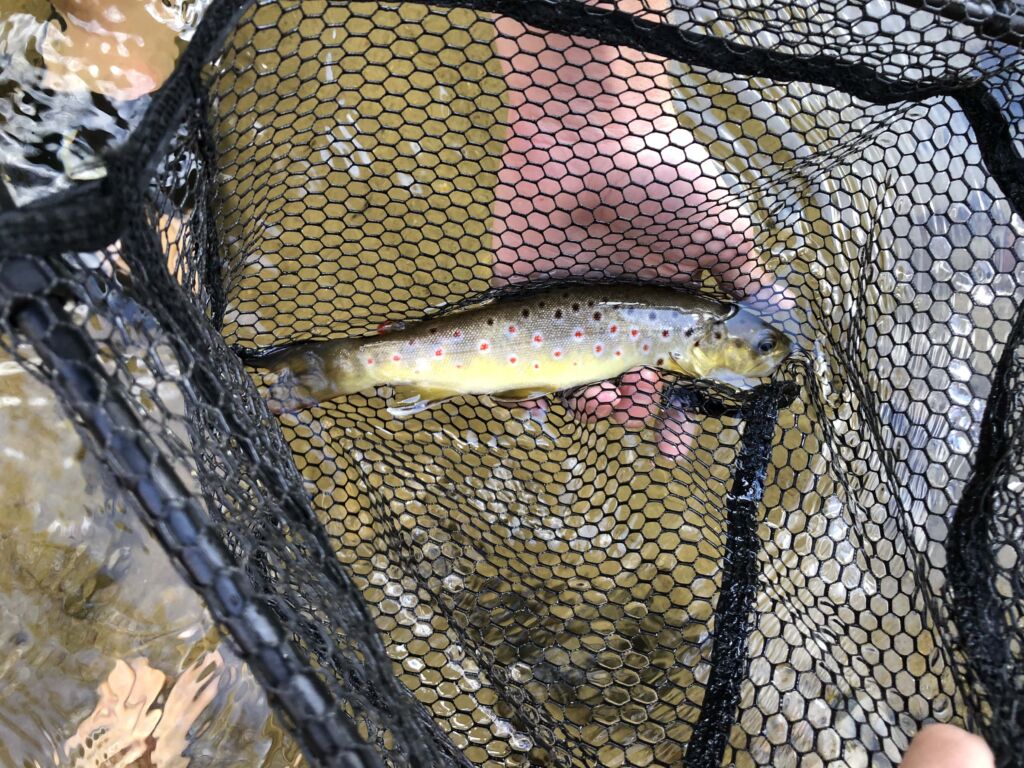
I haven’t talked about this much yet, but there is an important point I want to make with regard to changing your strategy based on certain conditions. If the water is really clear or the temperature is outside of that Goldilocks range I mentioned before, your presentation is going to have to be pretty much flawless. You’re going to want to be very quiet and stealthy and make sure your fly is looking good in the water. If the water clarity looks decent and you’re in that temperature range, ensuring your presentation is perfect is never a bad idea. Still, you will have a bit more wiggle room because the fish should, in theory, be feeding more aggressively.
Additionally, you want to use river features like eddies, rocks, and pools to your advantage. These trout should not be able to see you as well, and thus, you have a better chance of convincing the trout that your fly is actually just another real one like they normally eat.
Common Mistakes to Avoid in River Trout Fishing
When fishing in rivers and even more so fly fishing in general, there is a ton of room for error. As a result, I want to tell you about some common mistakes that anglers make so that you don’t have to make them yourself.
One of the biggest mistakes people make while fly fishing on rivers is that they’ll use their fly rod like a whip to where you can hear it actually cracking in the air. You can use YouTube to fix this problem. From personal experience, you will want to do this sooner than later because you will lose files if you keep this up. Instead, try to be smooth in your casting motion to prevent this from happening.
Read also: How to Fish in a River: Tips and Techniques
Another mistake that is common when trout fishing on rivers is anglers taking these monster casts. A lot of the time, you can use the current to your advantage and just feed out the line. Yes, you will need to cast out your fly sometimes, but sometimes, you only need to let it drift down.
Another mistake I see people make is not paying attention to their dry fly or indicator when they fly fishing on the river. Trout often doesn’t hit your flies that hard. This being said, when they give your fly a nibble or little bite, you have to be ready to set the hook. Don’t yank super hard; just pull the rod tip up so that you can set the hook, and the line is taught.
Advanced Techniques for Experienced Anglers
One of the most fun and rewarding things you can do as someone who is fishing in rivers for trout is to tie your flies. Not only will this save you money in the long run, but there is something special about catching a fish on a bait you have made yourself.
The flies might not look quite as good as the ones you buy in a store at first, but with a bit of practice, you can make good-looking flies in no time. Additionally, having the equipment to tie flies gives you the ability to adjust your tactics when you aren’t close to a fly shop, for example.
Say you are fishing the same river for a few days and notice that the trout in the river continue to come up and eat this small black and purple bug on the top of the water. The problem is that you don’t have a fly that can replicate that in your fly box, and you’re simply too far away from a fly shop. Then you remember that you have purple and black thread and dubbing in your box, and you can go home that night and make a fly from scratch based on what you’ve seen. The only thing left to do is come back and smoke the trout the next day.
Get your personalized fishing map
Answer a quick quiz and get your own personalized fishing map
I know I only offered one piece of advice for experienced anglers here, but trust me, it’s worth looking into.
Conclusion
I hope you guys have enjoyed reading this article detailing how to fish for trout in rivers. I know this was a ton to take, but I didn’t invest some time in reading it. Additionally, I would recommend just getting out on the river and trying some of these tactics. The best way to learn is through personal experience on the water, so get after it.
Thanks for reading the article, and, as always, good luck and tight lines!
Photo Source: All photos in this article were provided by expert Pierce Latta.
Visit his Instagram profile.
Subscribe to his YouTube channel.
